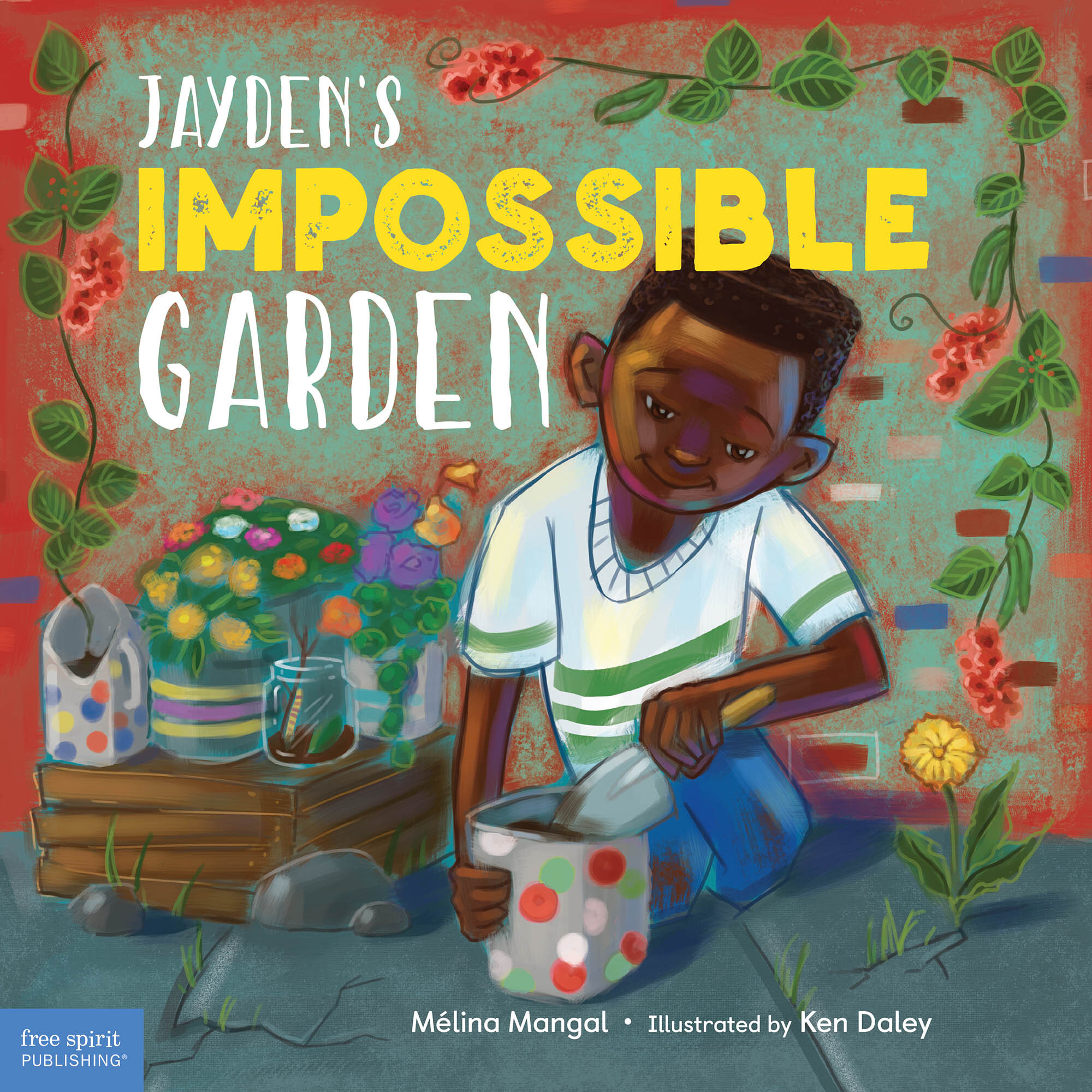
Inclusive Children's Book Teaching Guide
Jayden’s Impossible Garden
What is this book about?
Jayden’s Impossible Garden tells the story of Jayden, a Black boy who loves imaginative play, being outdoors and making things. Jayden’s love of nature will inspire young children to see the many opportunities for growth and connection that exist in their environments.
Amidst all the buildings, people and traffic in his neighborhood, Jayden sees nature everywhere: the squirrels scrounging, the cardinals calling and the dandelions growing. But Mama doesn’t believe there’s any nature in the city. So Jayden sets out to help Mama see what he sees.
With the help of his neighbor and new friend, Mr. Curtis, Jayden plants the seeds of a community garden and brings together his neighbors—and Mama—to show them the magic of nature in the heart of the city.
Timeless and vibrant, this story highlights the beauty of intergenerational relationships and the power of imagination and perseverance as a young boy and an elderly man in a wheelchair bring their vision of a community garden to life.
In the activities section at the back of the book, readers will learn how to make a milk jug bird feeder and other items featured in the story.
Winner of the 2019 African American Voices in Children's Literature writing contest.
Who is depicted in this book?
- A child whose interests transcend gender stereotypes
- A character with a physical disability
What early childhood themes and concepts does this book explore?
- Nature in the city
- Nurturing plants, animals and insects
How does this book support anti-bias education?
Jayden's love of nature inspires a diverse community to plant and care for an urban garden. Teachers can use this book to empower young children and send a message that people from all walks of life can work together to make the world a better place by putting their interests and gifts to work to benefit others.
Depending on how the book is shared or used—and the developmental level of the children—Jayden’s Impossible Garden may be used to support the following core goal from Anti-Bias Education for Young Children and Ourselves:
Identity—Teachers will nurture each child’s construction of knowledgeable and confident personal and social identities so that children will demonstrate self-awareness, confidence, family pride, and positive social identities.
How can this book be used to meet early childhood learning standards?
For all ages
Use Jayden’s Impossible Garden to meet early childhood literacy standards
For children from birth to age three
Teaching suggestion: Point out the actions of Jayden and the other characters (wash, look, dig, wave), as well as familiar objects and settings that the youngest children can react to, point at, or name.
What Illinois Early Learning Guideline does this meet for children from birth to age three?
Developmental DomainLanguage Development, Communication and Literacy
Standard: Early LiteracyChildren demonstrate interest in and comprehension of printed materials.
Indicators for children:
- Imitates gestures and sounds during activities (7–18 months)
- Repeats familiar words in a book while being read to (16–24 months)
Teaching suggestion: Work alongside the children to identify categories represented in the illustrations in this book (birds or animals, flowers or plants, cars, houses).
What Illinois Early Learning Guideline does this meet for children from birth to age three?
Developmental DomainLanguage Development, Communication and Literacy
Standard: Early LiteracyChildren demonstrate interest in and comprehension of printed materials.
Indicators for children:
- Begins to identify characteristics of the object, such as “red ball” (16–24 months)
- Identifies characteristics of objects and people when named, such as colors (21–36 months)
- Identifies categories, such as being able to point out all of the animals in a picture even with different types of objects represented (21–36 months)
For preschoolers (ages three to five)
Teaching suggestion: Connect this story to the children’s everyday lives by initiating a group discussion. Encourage the children to describe familiar places in the city depicted in the book.
What Illinois Early Learning and Development Standards does this meet for preschoolers?
Language Arts Standard1CUse language to convey information and ideas.
Benchmark 1.C.ECa:
Describe familiar people, places, things, and events and, with teacher assistance, provide additional detail.
Teaching suggestion: Identify events or illustrations in the book that show how Jayden builds a special relationship with Mr. Curtis. Discuss how we can show respect and support for one another’s choices and preferences.
What Illinois Early Learning and Development Standards does this meet for preschoolers?
Social/Emotional Development Standard31ADevelop positive relationships with peers and adults.
Benchmark 31.A.ECb:
Recognize the feelings and perspectives of others.
Benchmark 31.A.ECc:
Interact easily with familiar adults.
Benchmark 31.A.ECd:
Demonstrate attachment to familiar adults.
Teaching suggestion: Identify the problems that Jayden encounters in the book and discuss how he goes about solving them. For example, you might ask the children: "What problem was Jayden trying to solve when he used boxes to build a fort?"
What Illinois Early Learning and Development Standards does this meet for preschoolers?
Science Standard11ADevelop beginning skills in the use of science and engineering practices such as observing, asking questions, solving problems, and drawing conclusions.
Benchmark 11.A.ECa:
Express wonder and curiosity about their world by asking questions, solving problems, and designing things.
Teaching suggestion: Use this story to discuss ways that we can care for plants and animals while emphasizing the importance of nurturing life. You might ask: "Do the children know of any people who do this? Can they identify jobs that include this work?" Continue to support the children as they explore the natural world through pretend play and outdoor exploration.
What Illinois Early Learning and Development Standards does this meet for preschoolers?
Science Standard12AUnderstand that living things grow and change.
Benchmark 12.A.ECa:
Observe, investigate, describe, and categorize living things.
Benchmark 12.A.ECb:
Show an awareness of changes that occur in oneself and the environment.
Science Standard12BUnderstand that living things rely on the environment and/or others to live and grow.
Benchmark 12.B.ECa:
Describe and compare basic needs of living things.
Benchmark 12.B.ECb:
Show respect for living things.
See inside this book.

